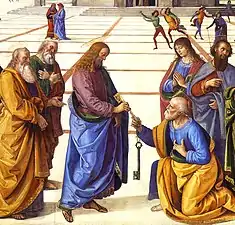| Part of a series on the |
| Knights Templar |
|---|
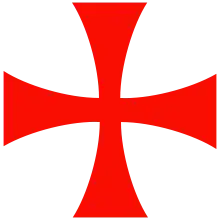 Templar Cross |
|
Poor Fellow-Soldiers of Christ and of the Temple of Solomon |
| Overview |
| Councils |
| Papal bulls |
|
| Locations |
| Successors |
| Cultural references |
| See also |
|
|

The grand master of the Knights Templar was the supreme commander of the holy order, starting with founder Hugues de Payens. Some held the office for life while others resigned life in monasteries or diplomacy. Grand masters often led their knights into battle on the front line and the numerous occupational hazards of battle made some tenures very short.
Each country had its own master, and the masters reported to the grand master. He oversaw all of the operations of the order, including both the military operations in the Holy Land and Eastern Europe, and the financial and business dealings in the order's infrastructure of Western Europe. The grand master controlled the actions of the order but he was expected to act the same way as the rest of the knights. After Pope Innocent II issued the bull Omne datum optimum on behalf of the Templars in 1139, the grand master was obliged to answer only to him.[2]
List of grand masters
| No. | Arms | Name | Time in office | Seat |
|---|---|---|---|---|
| 1 |  |
Hugues de Payens | c. 1119–1136 | Jerusalem (Kingdom of Jerusalem) |
| 2 |  |
Robert de Craon | 1136–1147 | |
| 3 |  |
Everard des Barres | 1147–1151 | |
| 4 |  |
Bernard de Tremelay (KIA)[lower-alpha 2] |
1151–1153 | |
| 5 | 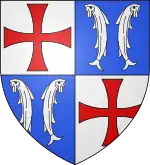 |
André de Montbard | 1153–1156 | |
| 6 |  |
Bertrand de Blanchefort | 1156–1169 | |
| 7 |  |
Philip of Milly | 1169–1171 | |
| 8 |  |
Odo of St Amand (POW)[lower-alpha 3] |
1171–1179 | |
| 9 |  |
Arnold of Torroja | 1181–1184 | |
| 10 |  |
Gerard of Ridefort (KIA)[lower-alpha 4] |
1185–1189 | Acre (Kingdom of Jerusalem) |
| 11 | 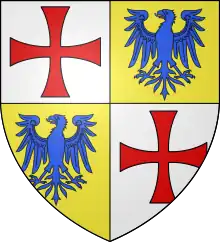 |
Robert of Sablé | 1191–1193 | |
| 12 |  |
Gilbert Horal | 1193–1200 | |
| 13 | 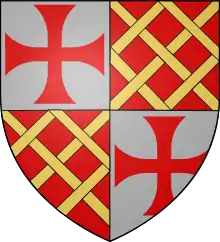 |
Phillipe de Plessis | 1201–1208 | |
| 14 | .svg.png.webp) |
William of Chartres | 1209–1219 | |
| 15 |  |
Peire de Montagut | 1218–1232 | |
| 16 |  |
Armand de Périgord (KIA/POW)[lower-alpha 5] |
1232–1244 | |
| 17 |  |
Richard de Bures[lower-alpha 5] | 1245–1247 | |
| 18 | 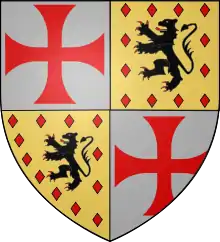 |
Guillaume de Sonnac (KIA)[lower-alpha 6] |
1247–1250 | |
| 19 | 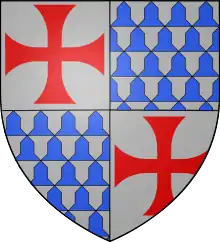 |
Renaud de Vichiers | 1250–1256 | |
| 20 |  |
Thomas Bérard | 1256–1273 | |
| 21 | 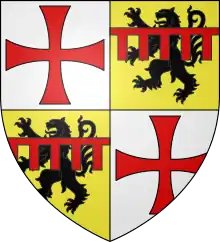 |
Guillaume de Beaujeu (KIA)[lower-alpha 7] |
1273–1291 | |
| 22 |  |
Thibaud Gaudin | 1291–1292 | Cyprus (Kingdom of Cyprus) |
| 23 |  |
Jacques de Molay | 1292–1312 |
See also
Notes
Footnotes
- ↑ According to the Beyeren Armorial.[1]
- ↑ Bernard de Tremelay was killed at the Siege of Ascalon.
- ↑ Odo of St Amand was captured at the Battle of Marj Ayyun.
- ↑ Gerard of Ridefort was killed at the Siege of Acre.
- 1 2 Armand de Périgord was either killed or captured at the Battle of La Forbie; authorities differ. Richard de Bures commanded the Templars until the election of Guillame de Sonnac; whether he was Grand Master is disputed.[3]
- ↑ Guillaume de Sonnac was killed at the Battle of Fariskur.
- ↑ Guillaume de Beaujeu was killed at the Siege of Acre.
References
- ↑ Wapenboek Beyeren (armorial)—KB79K21—folios 001v (left) and 002r (right). Wikimedia Commons. Retrieved February 7, 2021.
- ↑ Burman 1990, p. 40.
- ↑ Armand de Perigord (1178–1247). www.templiers.org. Retrieved February 7, 2021.
Bibliography
- Burman, Edward (1990). The Templars: Knights of God. Rochester: Destiny Books. ISBN 978-0-89281-221-9.
